Inpatient Census 2019: parts one and two
Results of the fifth Mental Health & Learning Disability Inpatient Census and Out of Scotland NHS Placements Census, 2019.
This document is part of a collection
4. Adult patients treated in NHS Scotland facilities (additional detail)
- There were 3,258 patients aged 18 and over at the 2019 Census
- 76% of adult patients had one mental health condition while 59% of patients also had a long-term physical health condition
- 92% of adult patients in the 2019 Census received some form of physical health check
This section looks at addition detail for adult patients (18+) occupying a mental health, addiction and learning disability bed in NHS Scotland. At the 2019 Census, there were 3,258 adult patients, a 4% decrease on the 2018 Census.
Specialty of Consultant
NHS Boards were asked to record the specialty of every consultant who was responsible for overseeing the treatment of a patient in the Census. A total of 1,382 (42%) adult patients were seen by a consultant whose speciality was "General Psychiatry" in the 2019 Census, the same proportion as 2017 and 2018. A further 1,181 (36%) adult patients were seen by a consultant under the speciality "Psychiatry of Old Age". This is 2 percentage points lower than 2018 and likely reflects the decrease in patients aged 65 and over in the 2019 Census.
Table 12: Proportion of adult patients by consultant speciality, NHS Scotland, 2016 – 2019
| Consultant Speciality | 2016 | 2017 | 2018 | 2019 |
|---|---|---|---|---|
| General Psychiatry | 43% | 42% | 42% | 42% |
| Forensic Psychiatry | 12% | 13% | 14% | 15% |
| Psychiatry of Old Age | 39% | 38% | 38% | 36% |
| Learning Disability | 5% | 5% | 4% | 4% |
| Addictions | 1% | 1% | < 1% | 1% |
* Does not include all consultant specialities due to small numbers
Legislation
Patients can be formally detained under the provisions of the Mental Health (Care and Treatment) (Scotland) Act 2003. However there is a range of legislation which patients can be subject to, and patients can be subject to more than one piece of legislation.
A total of 960 (29%) patients were subject to the Mental Health Act (Compulsory Treatment Order), while 927 (28%) were subject to the Adults with incapacity (Scotland) Act 2000. Some other legislation patients can be subject to are the Criminal Procedure Act and the Adult Support and Protection (Scotland) Act 2007.
Figure 5: Most adult patients in the 2019 Census were held under the Mental Health Act (Compulsory Treatment Order)
Psychiatric, Addiction or Learning Disability Inpatient Beds, NHS Scotland, Adult Patients (18+), 2019 Census
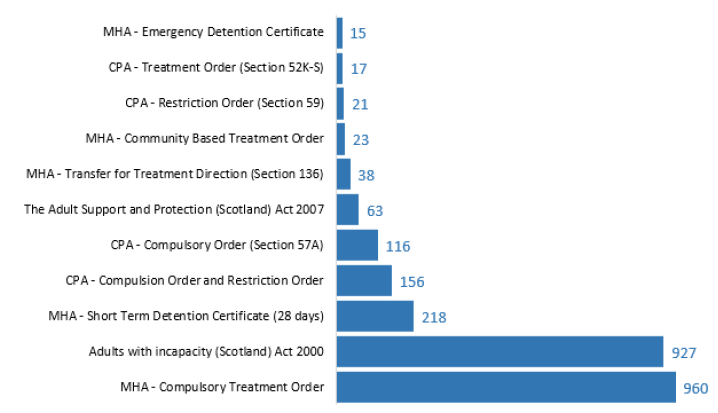
* MHA – Mental Health Act, CPA – Criminal Procedure Act
** Patients can be subject to more than one piece of legislation
*** Some data has been excluded due to small numbers
Health and Wellbeing
Mental health morbidities
NHS Boards returned diagnosis codes (ICD-10) for any mental health condition which patients in the 2019 Census had been diagnosed. Approximately 3 out of 4 adult patients with known mental health conditions (unknown data for 106 patients) had one mental health condition recorded in the 2019 Census. The proportion with 2 or more mental health conditions has increased from 22% in 2018 to 24% in 2019.
Figure 6: The proportion of adult patients with 2 or more mental health conditions in 2019 is 2 percentage points higher than 2018, and 4 percentage points higher than 2017
Psychiatric, Addiction or Learning Disability Inpatient Beds, NHS Scotland, Adult Patients (18+), 2019 Census
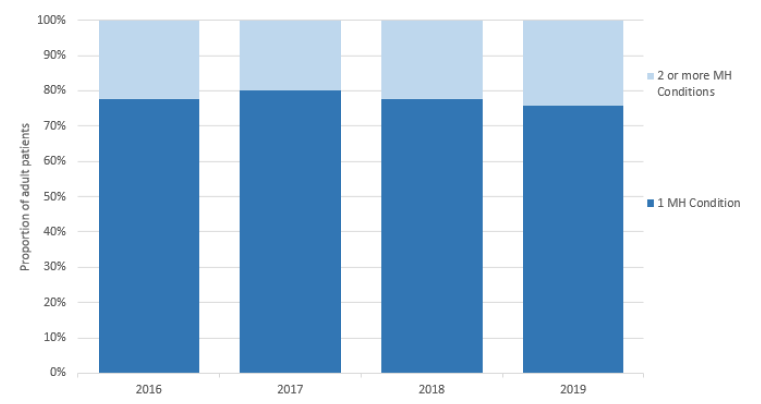
* Excludes patients with unknown diagnosis (2016- <10, 2017 - 86, 2018 - 124, 2019– 106)
The most commonly diagnosed mental health condition in the 2019 Census for adult patients was schizophrenia (28%), followed by dementia (25%) and personality disorder (11%). The proportion of patients with each condition has changed little since 2018, with the biggest difference a 2 percentage point decrease in the proportion of patients with dementia. The only other conditions to decrease from 2018 was depression and neurotic, stress-related & somatoform conditions, both by 1 percentage point. All other conditions either remained the same or increased by 1 percentage point.
Diagnosis counts include both primary and secondary diagnoses. In addition, separate questions on autistic spectrum disorder and personality disorder allowed for cross-comparison with diagnosis codes to pick up any patients missing relevant codes. It should also be noted that patients may have more than one diagnosis.
Learning Disabilities and Autism
Of the 3,258 adult patients in the 2019 Census, 294 (9%) had a diagnosis for either a learning disability or autism, a 1 percentage point increase on 2018. There were 229 (7%) adult patients with a diagnosis for learning disability and 147 (5%) with a diagnosis for autism (82 patients had a diagnosis for both).
Figure 7: There has been a 2 percentage point decrease in the proportion of adult inpatients with dementia from 2018 to 2019. This may reflect the decrease in the proportion of patients aged 65+ - Psychiatric, Addiction or Learning Disability Inpatient Beds, NHS Scotland, Adult Patients (18+), 2019 Census
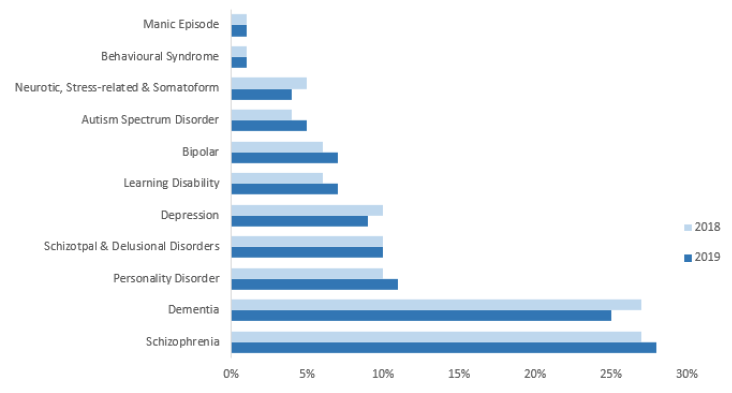
* Mental health diagnoses are based on ICD-10 codes. Primary and secondary diagnoses included
** Personality disorders and autistic spectrum disorder counts also rely on respective questions on these disorders
*** Patients may have more than one diagnosis
**** Some diagnoses not included due to small numbers
Physical health co-morbidities
The Mental Health Strategy 2017 – 2027 emphasises the importance of considering physical and mental health together as the outcomes of both are linked. A key outcome from the 2014 Census was the need to improve the recording of both mental and physical health morbidities. Mental health and learning disability services in NHS Boards are working towards routinely recording physical health conditions under the International Classification of Diseases. The 2016 Census included a suite of Yes/No physical health questions and these were retained for the 2019 Census.
List of yes/no physical health morbidities questions in the Census:
- Hypertension
- Diabetes
- Dyslipidaemia
- Chronic Obstructive Pulmonary Disease
- Coronary heart Disease
- Chronic Pain
- Epilepsy
- Sensory Impairment
- Chronic Kidney Disease
- Liver Disease
- Thyroid Disease
- Acquired Brain Injury
- Cancer
- Stroke / Transient Ischaemic Attack
- Alcohol Acquired Brain Injury
- Parkinson
There were 1,914 (59%) adult patients with at least one physical health co-morbidity based on the suite of Yes/No physical health questions at the 2019 Census. This is 1 percentage point lower than the 2018 Census but remains higher than the 58% figure reported in 2017 and 53% in 2016.
Most adult patients with a physical health co-morbidity returned one long term condition (39%). However, almost 1 in 5 adult patients had 4 or more physical health co-morbidities in the 2019 Census. The most common physical co-morbidity in the 2019 Census was hypertension (16% of all adult patients), followed by sensory impairment (15%) and diabetes (13%).
Figure 8: There has been a 2 percentage point decrease in the proportion of adult inpatients with sensory impairment and thyroid condition from 2018 to 2019
Psychiatric, Addiction or Learning Disability Inpatient Beds, NHS Scotland, Adult Patients (18+), 2019 Census
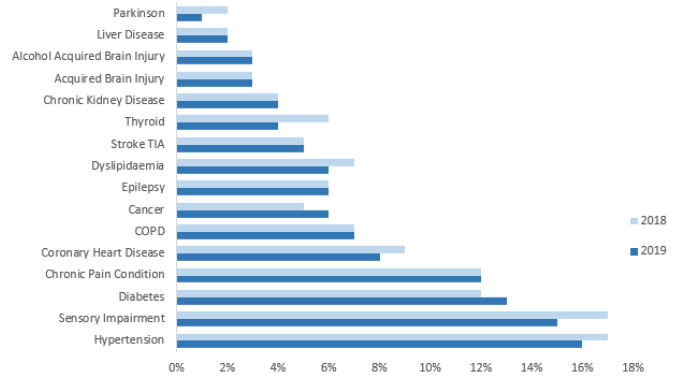
* Patients can have more than one physical condition
Physical Health Check
The 2017 Census included, for the first time, questions related to physical health checks. These follow on from actions on mental health set out by the Chief Medical Officer (http://www.sehd.scot.nhs.uk/cmo/CMO(2015)19.PDF). There are two questions;
- For patients admitted to a mental health bed within the last year: Did the patient receive a general physical examination by a qualified clinician within a day of admission?
- For patients admitted to a mental health bed over one year ago: Has the patient had an annual (physical) check within the last year? An annual health check should be both a physical assessment and delivery of health promotion activity.
Of the 2,077 adult patients for whom data on a general physical examination was returned, 1,917 (92%) received a general physical examination within a day of admission. This is 1 percentage point lower than the 2018 Census but 3 percentage points higher than 2017. A further 34 (2%) of patients were offered an examination but declined.
Of the 1,180 adult patients for whom data on an annual physical examination was returned, 1,066 (90%) received a health check within the last year. This is 1 percentage point lower than the 2018 Census but 8 percentage points higher than 2017. A further 29 (2%) of patients were offered an examination but declined.
Overall, 3,062 (92%) adult patients received some form of physical health check in the 2019 Census, the same as the 2018 Census and 5 percentage points higher than 2017.
Lifestyle factors
BMI (Body Mass Index)
BMI (Body Mass Index) was calculated for patients whom height and weight information was returned. A total of 104 patients were excluded because height and weight information was either not provided or were extreme outliers. Patients in eating disorder wards were also excluded.
Of the remaining adult patients, 1,117 (36%) had a normal BMI, while 60% were overweight or obese. There has been little change over time in the BMI of adult patients.
Table 13: Proportion of adult patients by Body Mass Index, NHS Scotland, 2016 – 2019
| BMI Category | 2016 | 2017 | 2018 | 2019 |
|---|---|---|---|---|
| Underweight | 6% | 6% | 5% | 5% |
| Normal | 36% | 37% | 37% | 36% |
| Overweight | 31% | 30% | 30% | 30% |
| Obese | 28% | 28% | 29% | 30% |
* Excludes patients in eating disorder wards
** 104 patients excluded due to missing data or extreme outliers
Smoking, alcohol and drug misuse
The Census includes a number of questions around alcohol and other substance misuse. It is known that not all patients with alcohol dependence or substance abuse will have a formal (ICD-10) diagnosis. This section contains analysis of patients with alcohol dependence and/or substance misuse based on responses from a combination of questions. A minor methodological change was made in 2017 (see Section 8 for further details).
A total of 1,170 (36%) adult patients smoked tobacco in the 12 weeks prior to the 2019 Census. This is a 4 percentage point increase on the 2018 Census and follows sustained decreases since 2016 where the proportion of adult patients smoking tobacco in the 12 weeks prior to admission was 35%. The proportion of adults smoking in the 2019 Census is much higher than the number of adults that smoke in Scotland (19%) as reported in the 2018 Scottish Health Survey.
In the 2019 Census, 687 (21%) of adult patients had a history of alcohol dependence in the four weeks prior to admission, of which 150 (22%) had an alcohol related diagnosis based on ICD-10 codes. The 21% of adult patients with a history of alcohol dependence in the four weeks prior to admission is a higher proportion than in previous surveys.
A total of 588 (18%) of adult patients had abused substances (excluding alcohol) in the four weeks prior to admission. Of these, 142 (24%) had a diagnosis of drug misuse based on ICD-10 codes. The proportion of adult patients who had abused substances (excluding alcohol) in the four weeks prior to admission is the same as 2018.
Figure 9: The proportion of adult patients with a history of alcohol dependence has increased by 3 percentage points since the 2016 Census
Psychiatric, Addiction or Learning Disability Inpatient Beds, NHS Scotland, Adult Patients (18+), 2019 Census
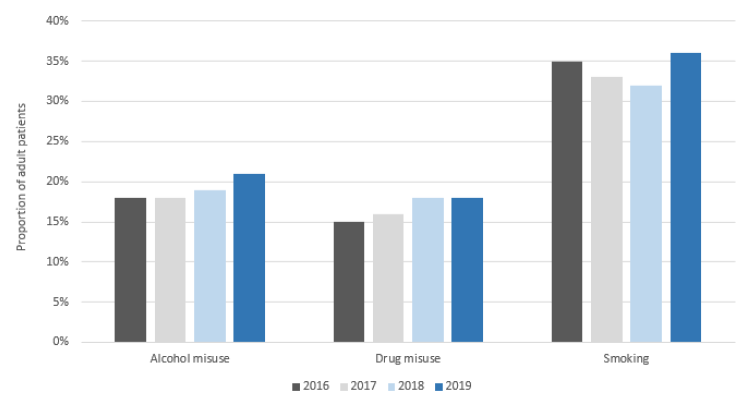
Substances used prior to admission
NHS Boards returned data on the substances used by the 588 adult patients with a history of substance misuse (excluding alcohol) in the four weeks prior to admission. The most prevalent substance was Cannabis, 361 (61%). Cocaine (14%) and Amphetamine (14%) were the next most prevalent, followed by heroin (12%).
Of the 588 patients with a record of substance abuse (excluding alcohol) in the four weeks prior to admission, 350 (60%) patients used only one substance, while 150 (26%) used two or more. Detailed information on substances used was not returned for 88 (15%) patients.
Table 14: Number of substances used by adult patients in 4 weeks prior to admission, NHS Scotland, 2016 – 2019
| Number of substances | 2016 | 2017 | 2018 | 2019 | ||||
|---|---|---|---|---|---|---|---|---|
| One | 291 | 56% | 316 | 59% | 334 | 55% | 350 | 60% |
| Two | 79 | 15% | 70 | 13% | 92 | 15% | 91 | 15% |
| Three | 41 | 8% | 34 | 6% | 34 | 6% | 25 | 4% |
| Four | 19 | 4% | 16 | 3% | 22 | 4% | 20 | 3% |
| Five or more | 13 | 2% | 24 | 4% | 16 | 3% | 14 | 2% |
| Not known | 79 | 15% | 79 | 15% | 106 | 18% | 88 | 15% |
Of the patients with recorded substance abuse in 4 weeks prior to admission, 372 (63%) used smoke or nasal as the main route of substance abuse, 156 (27%) oral and 33 (6%) injected (patients can use more than one route and data was not returned for all patients).
Self-harm
NHS Boards returned information on whether patients self-harmed in the week prior to admission. At the 2019 Census, 359 (11%) adult patients had self-harmed in the week prior to admission. This proportion is similar to previous years. Non-accidental injury was the most common form of self-harm in the 2019 Census, followed by poisoning.
There were no gender differences (50% male, 50% female) for adults self-harming the week prior to admission, however, given only 41% of adult patients in the Census are female, this suggests females are at a higher risk of self-harm compared with males.
While adult patients aged 18 – 39 years make up 25% of all adult inpatients in the 2019 Census, this age category represents 45% of those self-harming the week prior to admission, suggesting this age category are most at risk.
Figure 10: Adults aged 18-39 years represent the largest proportion of patients self-harming the week prior to admission, while those aged 65+ represent the lowest proportion
Psychiatric, Addiction or Learning Disability Inpatient Beds, NHS Scotland, Adult Patients (18+), 2019 Census
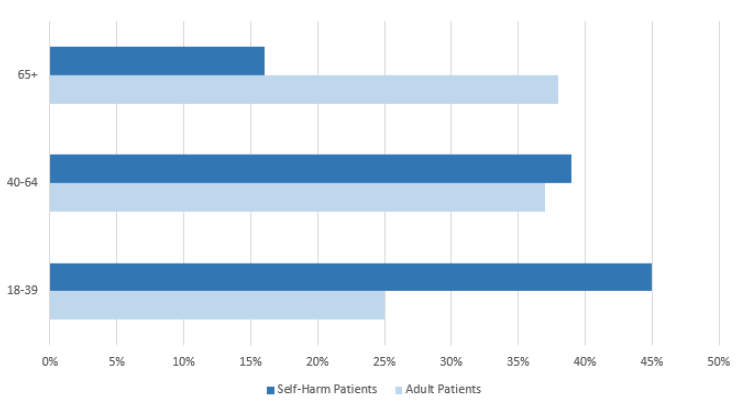
Suicidal ideation
NHS Boards returned information on whether patients were expressing suicidal ideation on admission. There were 362 (11%) adult patients expressing suicidal ideation on admission at the 2019 Census, 2 percentage points lower than 2018.
Females were more likely to be expressing suicidal ideation on admission (54%), as were those aged 18 – 39 (38%) and 40 – 64 (39%).
Contact
Email: SWStat@gov.scot
There is a problem
Thanks for your feedback